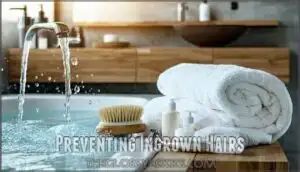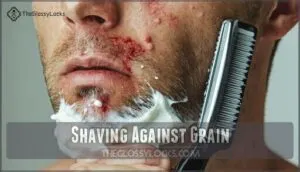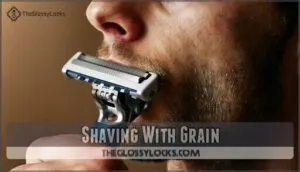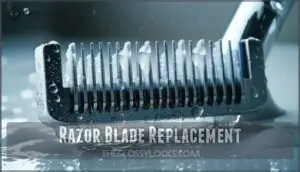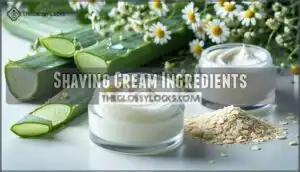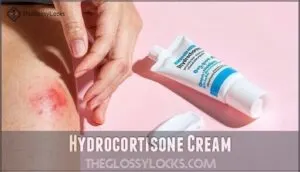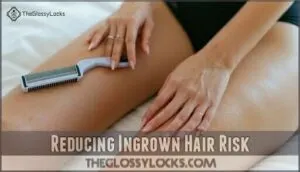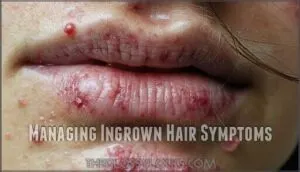This site is supported by our readers. We may earn a commission, at no cost to you, if you purchase through links.
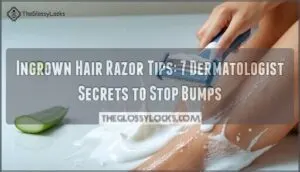
Ingrown hair razor tips can transform your shaving game from a battlefield to smooth sailing. Start with a sharp, multi-blade razor and quality shaving cream containing aloe or glycerin.
Always shave with the grain, not against it, and replace your blades regularly. Exfoliate gently before shaving to lift trapped hairs, and moisturize afterward to keep skin supple.
Don’t press too hard – let the razor do the work. These simple tweaks can slash your ingrown hair risk dramatically.
The secret lies in understanding why those hairs rebel in the first place.
Table Of Contents
- Key Takeaways
- Causes of Ingrown Hairs
- Preventing Ingrown Hairs
- Razor Tips for Shaving
- Treating Ingrown Hairs
- Reducing Ingrown Hair Risk
- Managing Ingrown Hair Symptoms
- Frequently Asked Questions (FAQs)
- How do I stop getting ingrown hairs when I shave?
- How to clear razor bumps asap?
- Can ingrown hairs cause permanent dark spots?
- How long do ingrown hairs take to heal?
- Are electric razors better for sensitive skin?
- Whats the difference between folliculitis and ingrown hairs?
- Can you get ingrown hairs from epilators?
- Conclusion
Key Takeaways
- Use sharp, single-blade razors – Replace your blades every 5-7 shaves and choose single-blade over multi-blade razors to prevent cutting hair too close to the skin
- Always shave with the grain – Follow your hair’s natural growth direction instead of against it to avoid creating sharp edges that curl back into follicles
- Exfoliate regularly before shaving – Gently exfoliate 2-3 times weekly with salicylic acid or physical scrubs to lift trapped hairs and remove dead skin cells
- Apply quality shaving cream and moisturize after – Use creams with aloe vera or glycerin for protection, then moisturize with fragrance-free lotion to keep skin supple and prevent irritation
Causes of Ingrown Hairs
You’re dealing with ingrown hairs because your hair follicles become trapped under the skin’s surface after shaving, creating those annoying red bumps that can turn into painful, pus-filled lesions.
Your hair type, shaving technique, and skin sensitivity all play key roles in determining whether you’ll develop these pesky bumps after your next shave, which can be influenced by shaving technique.
Hair Growth Patterns
Everyone experiences different hair growth patterns that directly affect ingrown hair formation.
Your hair texture and follicle depth determine how easily hairs curl back into skin after cutting.
Your hair’s natural texture sets the stage for whether those stubborn bumps will show up after your next shave.
Here’s what makes your hair more prone to ingrowns:
- Curly hair spirals naturally – creating sharp angles that pierce skin during regrowth
- Coiled follicles produce flattened hair shafts – 50% more likely to become ingrown than straight hair
- Shallow follicle angles – especially on your neck and jawline where hairs exit nearly parallel to skin
- Dense growth cycles – when multiple hairs regrow simultaneously in beard or pubic areas
- Genetic hair growth direction – some follicles naturally angle hair toward skin instead of outward
Your hair growth cycles also play a role, with shorter body hair phases increasing the risk of cutting hairs too close to the follicle during their active growth stage.
Understanding the causes of hair removal issues can help you take preventive measures to reduce ingrown hair formation.
Shaving Techniques
Poor shaving techniques create the perfect storm for ingrown hairs.
When you shave against the grain with dull blades, you’re basically cutting hair below skin level at sharp angles. This forces freshly cut hair to curl back and pierce surrounding tissue.
Dull blades drag and tear, creating perfect ingrown hair conditions.
Proper shave prep, maintaining skin tension, and using controlled shave strokes prevent razor burn treatment needs later.
Skin Types
Your skin type plays a starring role in ingrown hair development.
Sensitive skin reacts strongly to razor friction, while dry skin lacks the moisture needed for smooth hair emergence.
Oily skin can trap hairs beneath excess sebum, and combination skin creates mixed challenges across different facial zones.
Understanding your skin’s unique needs helps tailor your ingrown hair removal strategy effectively, addressing the specific challenges of your skin type and the role of sensitive skin.
Risk Factors
Several factors stack the odds against you regarding ingrown hairs.
Your hair type plays a starring role – coarse hair and curly textures create perfect conditions for hair curling back into follicles.
Skin sensitivity amplifies irritation from shaving frequency and clothing friction.
Product irritants in cheap shaving creams worsen hair follicle issues, while tight fabrics trap emerging hair growth underneath.
Preventing Ingrown Hairs
You can stop ingrown hairs before they start with the right prevention strategy.
The key lies in proper exfoliation, smart razor choices, and adjusting your shaving routine to work with your hair’s natural growth pattern.
Exfoliation Methods
Proper exfoliating techniques reveal smoother skin and fewer razor bumps. Chemical exfoliants like glycolic acid dissolve dead cells without scrubbing, while physical exfoliation uses gentle circular motions.
Stick to 2-3 times weekly—overdoing it backfires. Regular exfoliation can help prevent ingrown hairs from forming.
- Chemical exfoliants penetrating deep layers like tiny molecular janitors
- Exfoliation tools working as your skin’s personal cleaning crew
- Post-exfoliation care creating a protective moisture barrier
- Exfoliation frequency maintaining perfect timing for ingrown hair prevention
Shaving Creams
Quality shaving cream acts as your skin’s bodyguard against razor burn and ingrown hairs.
Look for moisturizing cream ingredients like aloe vera and glycerin that create a protective barrier during each pass.
| Cream Ingredients | Benefits for Sensitive Skin |
|---|---|
| Aloe vera | Soothes inflammation, reduces redness |
| Glycerin | Locks in moisture, softens hair follicles |
| Tea tree oil | Natural antimicrobial, prevents infection |
Proper application techniques matter—apply cream in circular motions to lift hairs.
For DIY shaving enthusiasts, cream alternatives like coconut oil work well for ingrown hair prevention.
Specialized formulas with allantoin are ideal for sensitive skin.
Razor Selection
Your razor choice can make or break your shaving game.
Single-blade razors trump multi-blade cartridges for preventing ingrowns—fewer blades mean less aggressive cutting.
Electric razors offer gentleness but sacrifice closeness.
Look for pivoting heads that follow facial contours and sharp, quality steel blades.
Replace cartridge razors after five shaves, safety razor blades weekly.
Clean your razor after each use to prevent bacterial buildup.
Some users prefer to buy a quality single blade.
Shaving Frequency
Instead of daily shaving habits that traumatize follicles, ideal frequency means giving your skin breathing room between sessions.
Hair regrowth cycles vary, but most people benefit from shaving every 2-3 days rather than daily.
This reduces skin sensitivity and allows natural hair removal processes to work.
Seasonal adjustments matter too—winter’s drier conditions may require less frequent shaving to prevent ingrown hairs.
Razor Tips for Shaving
Your razor choice and technique can make or break your fight against ingrown hairs. The right approach turns your daily shave from a skin disaster into smooth sailing.
Shaving Against Grain
Shaving against the grain delivers a closer shave but dramatically increases irritation levels and ingrown hair risk.
This technique refinement cuts hair below skin level, creating sharp edges that curl back into follicles. Your skin sensitivity determines tolerance—those with coarse or curly hair face greater hair damage.
Master proper shaving strokes and razor angles before attempting this advanced method. To help minimize irritation, consider soaking skin beforehand, and be aware of the potential for ingrown hair and irritation levels.
Shaving With Grain
Everyone benefits when you follow your hair’s natural direction – shaving with the grain reduces irritation by allowing your razor glide angle to work with hair growth direction.
This technique prevents hair from being cut too short, minimizing bumps and preventing re-entry into skin.
Your shaving strokes should mirror hair direction for reduced irritation and fewer ingrown hair problems, ensuring a smoother experience by working with hair growth direction.
Razor Blade Replacement
While dull blades tug and scrape your skin, sharp ones glide smoothly without causing ingrown hairs.
Replace blades every 5-7 shaves for ideal blade sharpness and razor hygiene. Daily shavers need weekly replacement frequency, while occasional users can stretch to two weeks.
Store your razor in a dry place—wet environments breed bacteria and rust. You can find options for razor head replacements online.
Proper blade storage and razor maintenance tips like thorough rinsing extend razor blade replacement intervals while preventing infection.
Shaving Cream Ingredients
Right razor blade sharpness matters, but your shaving cream ingredients make the real difference for sensitive skin.
Look for hydrating ingredients like aloe vera and glycerin that create protective barriers against razor burn.
Skip products with heavy fragrances that trigger skin irritation, and consider natural alternatives containing oatmeal or chamomile that offer gentle, effective protection.
Quality shaving tips always emphasize ingredient benefits over fancy packaging.
Treating Ingrown Hairs
When you already have ingrown hairs, swift treatment prevents infection and scarring. The right combination of gentle care and targeted treatments will free trapped hairs and calm irritated skin.
Warm Compresses
When stubborn bumps appear after shaving, warm compresses become your gentle rescue remedy. Heat dilates follicles, allowing trapped hairs to surface naturally while reducing painful inflammation.
Here’s your compress protocol:
- Compress Temperature: Use water heated to comfortable warmth—think hot tea temperature, not scalding coffee
- Application Frequency: Apply for 10-15 minutes, three times daily until hair emerges
- Compress Materials: Clean washcloth soaked in warm water works perfectly; disposable cotton pads are alternatives
- Post-Compress Care: Pat skin dry gently, then apply fragrance-free moisturizer to maintain hydration
- Infection Prevention: Use fresh, clean cloths each time to prevent bacterial contamination of sensitive follicles
Salicylic Acid Treatments
Since salicylic acid works as a beta hydroxy acid, you’ll find effective ingrown hair solutions in 1-2% concentrations.
Apply these exfoliation products daily or every other day after cleansing. Most people see results within two weeks of consistent treatment duration.
Choose from cleansers, creams, or wipes based on your skin care routine. Many users find acid-based relief for this condition.
Watch for mild dryness or irritation as common side effects, and consider salicylic acid as a key ingredient for ingrown hair solutions.
Hydrocortisone Cream
Applying hydrocortisone cream offers quick redness relief and itch reduction for inflamed ingrown hairs.
Use 1% over-the-counter strength sparingly twice daily for cream application.
Limit usage to seven days maximum to avoid side effects like skin thinning.
This gentle razor burn treatment calms irritated follicles while supporting your skin care routine’s healing process.
Antibiotic Ointments
While hydrocortisone helps calm inflammation, infected ingrown hairs need stronger intervention.
OTC antibiotic ointments prevent bacterial infection and speed healing when applied correctly.
Here’s your antibiotic ointment strategy:
- Choose bacitracin or triple antibiotic cream – Apply thin layer twice daily to prevent bacterial resistance from overuse
- Watch for side effects – Stop if you develop redness, itching, or worsening symptoms that signal allergic reactions
- Consider alternative treatments – Tea tree oil offers natural antimicrobial properties without prescription requirements
Reducing Ingrown Hair Risk
While shaving habits play the biggest role in preventing ingrown hairs, your daily routine and clothing choices can make or break your efforts.
The right skincare approach and wardrobe tweaks create an environment where hairs grow freely instead of getting trapped under your skin, which is crucial for preventing ingrown hairs.
Alternative Hair Removal
Several hair removal methods reduce ingrown hair risk compared to traditional shaving.
Laser hair removal proves most effective, requiring 6-8 sessions for permanent results.
Waxing alternatives like sugaring methods offer 3-4 week results with less irritation.
Hair removal creams dissolve hair below skin level, preventing sharp edges that cause ingrowns.
| Method | Duration | Ingrown Risk |
|---|---|---|
| Laser Hair Removal | Permanent | Lowest |
| Electrolysis Benefits | Permanent | None |
| Waxing Alternatives | 3-4 weeks | Low |
| Hair Removal Creams | 1-2 weeks | Minimal |
These hair removal techniques target the root cause—sharp, angled hair ends from razor cuts that curl back into skin, which is a key factor in reducing ingrown hair risk with methods like waxing alternatives and hair removal creams.
Skin Care Routine
Your skin care routine acts as your first line of defense against ingrown hair formation.
Pre-shave prep with warm water and gentle exfoliation removes dead skin cells that trap emerging hairs.
Post-shave care involves applying fragrance-free moisturizer twice daily to maintain your skin’s protective barrier.
Regular skin exfoliation using salicylic acid products prevents follicle blockage while moisturizing benefits keep skin supple and healthy, ensuring a strong protective barrier and promoting healthy skin.
Loose Clothing
When choosing what to wear after shaving, loose clothing becomes your skin’s best friend for preventing razor bumps.
Tight garments create friction that traps hairs and blocks follicles, while breathable fabrics allow proper air circulation and reduce skin irritation.
- Cotton breathability: Natural fibers like cotton allow airflow that keeps freshly shaved skin cool and dry
- Friction reduction: Loose-fitting clothes minimize rubbing against sensitive post-shave areas, preventing hair follicle irritation
- Circulation benefits: Unrestricted clothing promotes healthy blood flow, supporting skin healing and reducing inflammation risk
Avoiding Tight Clothing
Tight clothing creates a perfect storm for ingrown hairs by trapping perspiration and creating constant friction against freshly shaved skin.
Your post-shave clothing choice matters more than you think. Swap those compression leggings for looser alternatives that allow skin breathability.
Fabric choice impacts razor bump prevention substantially – cotton beats synthetic materials that lock in moisture.
Smart athleisure alternatives reduce clothing friction while maintaining comfort and style. This is because friction can trap hair under the skin.
Managing Ingrown Hair Symptoms
When ingrown hairs strike, you’ll want fast relief from the angry red bumps that can make shaving feel like a nightmare.
The good news is that with the right approach, you can calm inflammation, reduce redness, and prevent lasting damage while your skin heals, which is crucial for achieving fast relief.
Redness Reduction
When razor burn strikes, you need quick relief.
Cool compresses work fast—apply for 5 minutes to calm angry skin.
Follow with aloe application for instant soothing.
Tea tree oil fights bacteria while reducing redness.
Hydrocortisone use brings down inflammation within hours.
The moisturizing benefits of fragrance-free lotions prevent further irritation.
Skip warm compress here—cold’s your friend for immediate skin redness relief.
The use of cool compresses and aloe application can provide quick and effective relief.
Inflammation Treatment
Cool compresses immediately calm angry inflammation when applied for 10-15 minutes several times daily.
Tea tree oil’s natural anti-inflammatory properties work wonders when diluted properly. Aloe vera gel soothes irritated follicles like a gentle healing balm.
Over-the-counter steroid creams reduce swelling fast, while severe cases might need medical drainage by professionals for infected bumps, which can be treated with natural remedies.
Scarring Prevention
While reducing skin inflammation helps prevent long-term damage, protecting your skin from permanent scarring requires consistent care.
Resist the urge to pick at ingrown hair bumps, as this creates deeper wounds and increases scarring risk. One helpful tip is to exfoliate the skin to prevent ingrown hairs.
Key scarring prevention strategies:
- Minimize Picking – Keep hands away from affected areas to prevent tissue damage
- Apply Scar Creams – Use silicone-based products on healing bumps
- Maintain Sun Protection – UV exposure darkens scars and causes skin discoloration
- Support Proper Healing – Keep skin moisturized and avoid harsh scrubbing
- Schedule Dermatologist Consult – Get professional treatment for persistent skin irritation before scarring develops
When to Consult Doctor
Why ignore warning signs when your skin’s screaming for help? Some ingrown hairs need professional attention, especially with Infection Signs like pus or spreading redness.
Dermatologists recommend seeing your healthcare provider when Treatment Failure occurs after home remedies, Persistent Irritation lasts beyond a week, or Severe Pain develops with fever.
| Warning Sign | Action Needed |
|---|---|
| Pus, fever, spreading redness | Immediate medical care |
| Scarring Concerns or chronic bumps | Dermatologist consultation |
| Skin infections not improving | Antibiotics may be required |
Don’t let stubborn ingrown hair problems turn into bigger issues.
Frequently Asked Questions (FAQs)
How do I stop getting ingrown hairs when I shave?
Use sharp razors, shave with hair growth, exfoliate regularly, apply warm water before shaving, use quality shaving cream, and moisturize afterward. Replace blades every 5-7 shaves for best results.
How to clear razor bumps asap?
Apply cool compresses immediately to reduce inflammation, then use hydrocortisone cream sparingly. Exfoliate gently with salicylic acid to release trapped hairs. Don’t pick or squeeze—you’ll make it worse.
Can ingrown hairs cause permanent dark spots?
Ironically, what’s meant to smooth your skin can leave lasting marks.
Yes, ingrown hairs can cause post-inflammatory hyperpigmentation—those stubborn dark spots that stick around long after the bump’s gone, especially on darker skin tones.
How long do ingrown hairs take to heal?
Most ingrown hairs heal within one to two weeks with proper care. You’ll see improvement faster if you avoid picking and use gentle exfoliation and moisturizing daily.
Are electric razors better for sensitive skin?
Like a gentle breeze versus harsh winds, electric razors offer a softer approach for sensitive skin.
They cut hair without direct blade contact, reducing irritation and razor burn substantially compared to traditional razors.
Whats the difference between folliculitis and ingrown hairs?
Folliculitis is inflammation of hair follicles caused by bacteria, fungi, or irritation, while ingrown hairs occur when hair curves back into skin after cutting, creating trapped strands that cause bumps.
Can you get ingrown hairs from epilators?
Yes, you can definitely get ingrown hairs from epilators.
These devices pull hair from the root, and when it regrows, it can curl back into your skin just like with other hair removal methods, which can lead to ingrown hairs.
Conclusion
Think of your skin as a garden where proper cultivation prevents weeds from taking root.
These ingrown hair razor tips aren’t just cosmetic fixes—they’re evidence-based strategies that dermatologists rely on daily.
You’ve learned the science behind why hairs rebel and exactly how to stop them.
Consistent exfoliation, sharp blades, and gentle technique create the perfect storm for smooth skin.
Remember, prevention beats treatment every time.
Your razor doesn’t have to be your enemy when you follow these proven methods.
- https://lane44.com/blogs/bumps-burns-ingrowns/what-is-the-best-razor-to-avoid-ingrown-hairs
- https://www.gillettevenus.com/en-us/womens-shaving-guide/sensitive-skin/shaving-with-ingrown-hairs/
- https://www.youtube.com/watch?v=NOnUQjcnva8
- https://www.naircare.com/en/education/how-to-get-rid-of-ingrown-hairs
- https://www.gillette.co.uk/blog/how-to-shave/how-to-avoid-developing-ingrown-hairs-when-shaving/

